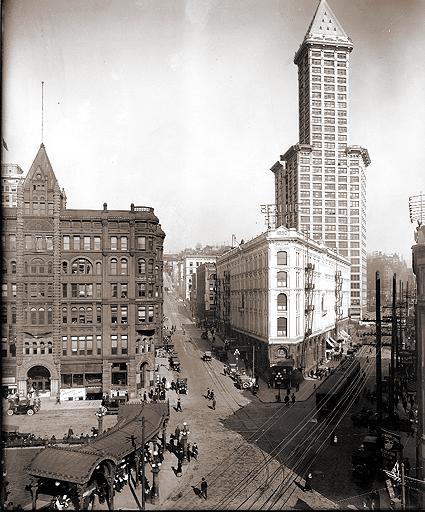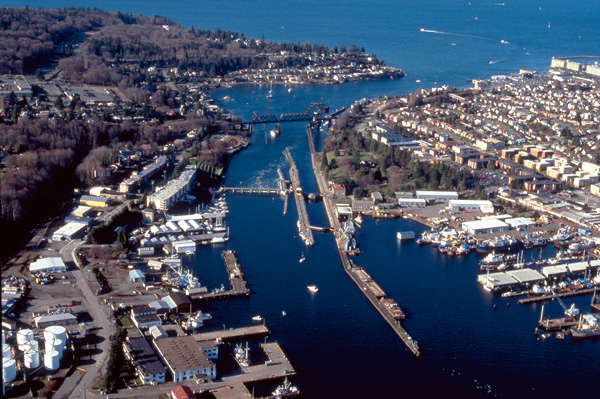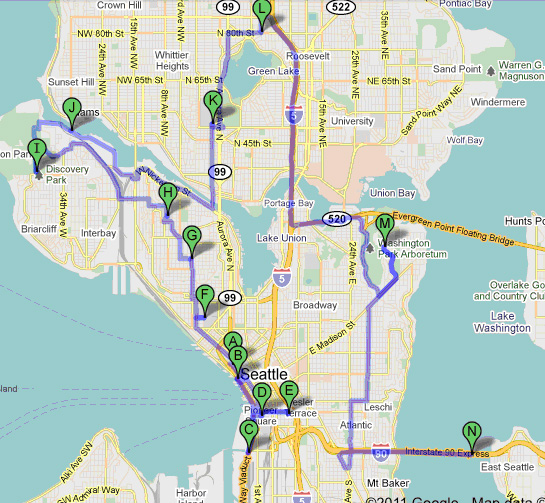The Travels of a Journalistâ€â€ÂÂ55 Rebuff by insensitive Canada consul helps family explore more of Seattle
Posted on February 11th, 2011
By Shelton A. Gunaratne ƒÆ’-¡ƒ”š‚©2011 Professor of mass communications emeritus@ Minnesota State University Moorhead
ƒÆ’-¡ƒ”š‚ On Friday (11 Aug. 1989), my mother and my elder sister ƒÆ’‚¢ƒ¢-¡‚¬ƒ…-RaniƒÆ’‚¢ƒ¢-¡‚¬ƒ”š‚ joined usƒÆ’‚¢ƒ¢-¡‚¬ƒ¢¢”š¬‚Carmel, Junius, Yoke-Sim and meƒÆ’‚¢ƒ¢-¡‚¬ƒ¢¢”š¬‚to explore Seattle (pop. 630,320), the most populous city in the Pacific Northwest, 128 miles north of Longview. Because ƒÆ’‚¢ƒ¢-¡‚¬ƒ…-RaniƒÆ’‚¢ƒ¢-¡‚¬ƒ”š‚ expressed a wish to see a ƒÆ’‚¢ƒ¢-¡‚¬ƒ…-little bit of CanadaƒÆ’‚¢ƒ¢-¡‚¬ƒ”š‚ before her departure back to Sri Lanka on Monday (14 Aug.), we thought of crossing over to Vancouver, B.C., as well.
However, being a Sri Lanka passport holder, ƒÆ’‚¢ƒ¢-¡‚¬ƒ…-RaniƒÆ’‚¢ƒ¢-¡‚¬ƒ”š‚ had to get a visa to visit Canada. I thought getting a visa for a day trip to Canada would pose no problem.ƒÆ’-¡ƒ”š‚ But when we stopped by at the Canadian consulate general in Seattle at 8.30 a.m., the consular official refused her a visa on suspicion that ours was a ploy to deposit ƒÆ’‚¢ƒ¢-¡‚¬ƒ…-RaniƒÆ’‚¢ƒ¢-¡‚¬ƒ”š‚ in Canada as a refugee seeking ƒÆ’‚¢ƒ¢-¡‚¬ƒ…-permanentƒÆ’‚¢ƒ¢-¡‚¬ƒ”š‚ residence. The official refused to budge even when I, in my capacity as a permanent resident of the United States, agreed to guarantee her return with us on the same day.ƒÆ’-¡ƒ”š‚ (Apparently, the Tamil exodus from Sri Lanka to Canada claiming refugee status had triggered the suspicion of the consular general.)
We promptly decided to change our plans and spend the day exploring the city of Seattle, the administrative seat of King County, located on a narrow isthmus between Puget Sound/Pacific Ocean and Lake Washington. The much larger Seattle Metropolitan Area (pop. 3.4 million) consists of King and Snohomish counties (covering the tri-city division of Seattle, Bellevue and Everett) and Pierce County (covering the Tacoma division).
Because my mother wanted to see an American public market, we began our exploration of Seattle with a visit to the Pike Place Market (85 Pike St.), a Seattle landmark created in 1907 in the northwest section of downtown between Belltown and Elliott Bay. Built on the edge of a steep hill, the upper street level of the market accommodates fishmongers, fresh produce stands and craft stalls operating in the covered arcades. The market also has several lower levels, located below the main level, each of which featuring a variety of unique shops: antique dealers, comic book sellers, and small family-owned restaurants (Wikipedia). The site still has one of SeattleƒÆ’‚¢ƒ¢-¡‚¬ƒ¢-¾‚¢s few remaining head shops [retail outlets for New Age herbs and drug paraphernalia].
My sister, who had never visited the world outside Sri Lanka before her current U.S. visit, immediately perceived the spontaneous mayhem of the Dehiwela public market, not too far from our one-time home on Terrence Avenue, Mount Lavinia, and the managed mayhem at Pike Place Market. My mother was equally delighted to imagine herself ƒÆ’‚¢ƒ¢-¡‚¬ƒ…-teleportedƒÆ’‚¢ƒ¢-¡‚¬ƒ”š‚ to an environment similar to that of Sri Lanka.
From Pike Place, we crossed the Alaskan Way Viaduct over to Pier 59 adjoining the Waterfront Park. Carmel and Junius insisted on visiting the Seattle Aquarium on Pier 59. The city of Seattle opened the aquarium in 1977 (the year that Seattle Marine Aquarium on Pier 56 ceased to exist) as ƒÆ’‚¢ƒ¢-¡‚¬ƒ…-a vital force for marine conservation.ƒÆ’‚¢ƒ¢-¡‚¬ƒ”š‚ƒÆ’-¡ƒ”š‚ (The non-profit Seattle Aquarium Society took over the management of the facility in 2010. The current admission to the aquarium is $19 with concessions allowed for students.) While Carmel and Junius explored the aquarium, the rest of us enjoyed the picnic facilities and the fountain in the adjoining Waterfront Park, which extends from the privately owned Pier 57 to Pier 59ƒÆ’‚¢ƒ¢-¡‚¬ƒ¢¢”š¬‚the area once known as Schwabacher Wharf/Dock. The U.S. military used this spot during World War II. A larger-than-life bronze statue of Christopher Columbus graced the sound/ocean end of the park.ƒÆ’-¡ƒ”š‚
We had to choose among the many attractions in and around Downtown Seattle. (We agreed to skip the Museum of History and Industry, Museum of Flight, and Thomas Burke Memorial Washington State Museum.)
Our choice for a visit was the free Coast Guard Museum of the Northwest (1519 Alaskan Way South), about 1.6 miles from Pier 59 along Puget Sound. It houses more than 3,000 books and periodicals on U.S. Coast Guard and Pacific Northwest maritime history; more than 2,500 historical documents, clippings and vessel plans; and more than 15,000 photographs (Wikipedia). It illustrates the numerous roles that the Coast Guard plays using a variety of artifacts ranging from life-saving stations to rescue boats; from buoy tenders to icebreakers and weather ships; and from modern aircraft to patrol boats and cutters.
Driving back toward the southwest corner of downtown, we stopped at the Pioneer Square-Skid Road Historic District, where the pioneer folks of Seattle settled in 1852 after entrepreneur Henry Yester set up his lumber mill on Elliott Bay. The area south of Yester Way (originally called Mill Street) became, in the words of historian Henry Broderick, a restricted area of ƒÆ’‚¢ƒ¢-¡‚¬ƒ…-a massive collection of the demimonde.ƒÆ’‚¢ƒ¢-¡‚¬ƒ”š‚ƒÆ’-¡ƒ”š‚ The neighborhood had “parlor houses” with marquees, celebrity madamesƒÆ’‚¢ƒ¢-¡‚¬ƒ¢¢”š¬‚among them Lou Graham, Lila Young, and Raw McRobertsƒÆ’‚¢ƒ¢-¡‚¬ƒ¢¢”š¬‚and piano “professors.” The city was tolerant of scrupulous parlor houses, but failed to deal with the far more controversial “crib houses” such as the Midway, the Paris and Dreamland. As Wikipedia describes:ƒÆ’-¡ƒ”š‚ ƒÆ’-¡ƒ”š‚ ƒÆ’-¡ƒ”š‚
ƒÆ’‚¢ƒ¢-¡‚¬ƒ…-Besides the brothels there were ƒÆ’‚¢ƒ¢-¡‚¬ƒ”¹…”an ungodly mixture of dives, dumps ƒÆ’‚¢ƒ¢-¡‚¬ƒ”š‚¦ pawnshops, hash houses, dope parlors and ƒÆ’‚¢ƒ¢-¡‚¬ƒ”š‚¦ the et cetera that kept the police guessing.ƒÆ’‚¢ƒ¢-¡‚¬ƒ¢-¾‚¢ Box houses prosperedƒÆ’‚¢ƒ¢-¡‚¬ƒ¢¢”š¬‚part theater, part bar, part brothel, as did all sorts of gambling.ƒÆ’‚¢ƒ¢-¡‚¬ƒ”š‚
The Great Seattle Fire of 1889 destroyed the Pioneer Square settlement of wooden structures. Late Victorian-style and Romanesque Revival brick and stone buildings replaced the burnt wooden structures. The prospectors involved in the Klondike Gold Rush 1897-1898 used Seattle as a center for travel to Alaska and helped the rebuilding of Pioneer Square.
Seattleites still regard Pioneer Square as the center of the cityƒÆ’‚¢ƒ¢-¡‚¬ƒ¢-¾‚¢s nightlife.
 A 1917 photo of Pioneer Square by C.F. Todd. Smith Tower and (below it) Seattle Hotel are on the far right. Pioneer Building is on the left.(Source: Wikimedia Commons)
A 1917 photo of Pioneer Square by C.F. Todd. Smith Tower and (below it) Seattle Hotel are on the far right. Pioneer Building is on the left.(Source: Wikimedia Commons)
Our exploration of Seattle included visits to the Pioneer Square unit of the Klondike Gold Rush Historic Park (free admission) and the Smith Tower, the oldest skyscraper in Seattle, located at 506 Second Ave. Named after the firearm and typewriter magnate Lyman Cornelius Smith, who built it in 1914, the 38-storey tower has a pinnacle height of 489 ft.ƒÆ’-¡ƒ”š‚ (General admission is $7.50)
We ate lunch at the nearby Occidental Park. We cruised through The Chinatown- International District (dubbed ƒÆ’‚¢ƒ¢-¡‚¬ƒ…-Little SaigonƒÆ’‚¢ƒ¢-¡‚¬ƒ”š‚), one of the oldest sections of Seattle, on the eastern side of Pioneer Square. A notable landmark in the area is Uwajimaya, the family owned Asian-food supermarket founded in 1928 by Fujimatsu Moriguchi.
After lunch, we explored the 74-acre Seattle Center, a park and arts-and entertainment center north of downtown.ƒÆ’-¡ƒ”š‚ Although admission to the park is free, not all of its attractions are free. The centerƒÆ’‚¢ƒ¢-¡‚¬ƒ¢-¾‚¢s array of attractions includes the International Fountain; the Space Needle; the Monorail terminus; the Food Circus (later named Center House) with a repertory theater and a childrenƒÆ’‚¢ƒ¢-¡‚¬ƒ¢-¾‚¢s museum; the Science Fiction Museum/the Experience Music Project; the Fisher Pavilion; the Kobe Bell; the Mercer Arena; the Northwest Rooms; and the Seattle Center Pavilion.ƒÆ’-¡ƒ”š‚ ƒÆ’-¡ƒ”š‚
Seattle built the International Fountain (305 Harrison St.) for the 1962 WorldƒÆ’‚¢ƒ¢-¡‚¬ƒ¢-¾‚¢s Fair. With more than 20 spouts, the fountain goes through programmed cycles of shooting water patterns, accompanied by recorded world music.
Our focus was its star attraction, the towering 605-ft high Space Needle (400 Broad St.), built as the centerpiece for the 1962 World’s Fair. Its width at the broadest point is 138 ft.ƒÆ’-¡ƒ”š‚ An observation deck at the 520-ft level provides panoramic views of the city. It has the capacity to withstand winds up to 200 mph, and earthquakes up to 9.1 magnitude.ƒÆ’-¡ƒ”š‚ Its 25 lightning rods at the top provide protection against lightning damage. The current general admission to the Space Needle is $18.
The Monorail terminus also dates back to 1962 WorldƒÆ’‚¢ƒ¢-¡‚¬ƒ¢-¾‚¢s Fair. The cost of a roundtrip ride from Seattle Center to the Westlake Central is $4. Each trip takes two minutes to cover the one-mile route.
The Center House was built in 1939 to accommodate the old Armory. During the 1962 World Fair, it was converted to the Food Court. In the early 1970s, the Food Circus was renamed Center House after some minor renovations. In 1985, the Children’s Museum moved into the first floor of the building and expanded its space in 1995, building a giant toy mountain for the Alhadeff Exhibit Center. Today, more than 3,000 free public performances occur in Center House each year.
Because we were running out of time to explore other attractions in Seattle Center, we decided to drive northwards through the stately Queen Anne Hill neighborhood, on our way to visit the 534-acre Discovery Park in the Magnolia Peninsula in northwest Seattle.
SeattleƒÆ’‚¢ƒ¢-¡‚¬ƒ¢-¾‚¢s early economic and cultural elite splurged their wealth to build their mansions on the hill. A sharp incline of the hill separates and segregates the elites ensconced in the Upper Queen Anne from the hoi polloi of the Lower Queen Anne (also known as Uptown) inhabiting the area immediately to the west and north of Seattle Center. Architects originally designed, but failed to complete, the Queen Anne Boulevard as a three-mile loop around the crown of the hill. Examples of the many mansions on Queen Anne Hill are the Gable House on West Highland Drive and George KinnearƒÆ’‚¢ƒ¢-¡‚¬ƒ¢-¾‚¢s home at 809 Queen Anne Ave. N.
From Seattle Center, we drove north on Queen Anne Avenue North and then turned northwest at North Queen Anne to reach Discovery Park, six miles or so away. Built on the historic grounds of Fort Lawton, the park contains the historic West Point Lighthouse as well. It is also the home of the Daybreak Star Cultural Center of the United Indians of All Tribes.ƒÆ’-¡ƒ”š‚ Its 12 miles of hiking trails is a bonanza for the outdoor enthusiasts.
We left the park after a stop at the visitorsƒÆ’‚¢ƒ¢-¡‚¬ƒ¢-¾‚¢ center to get to our star attraction of the dayƒÆ’‚¢ƒ¢-¡‚¬ƒ¢¢”š¬‚Lake Washington Ship Canal and Hiram Chittenden Locks, about 1.5 miles north of Discovery Park. Located on the west end of Salmon Bay, the Ballard Locks, as they are locally known, prevent the saltwater intrusion of Lake Washington and other freshwater lakes; and facilitate the movement of boats from the water levels of the lakes to the water level of Puget Sound. They also maintain the fresh water level of the lakes at 20-22 ft. above sea level. The U.S. Army Corps of Engineers has operated the complex of two locks, a spillway and a fish ladder since 1906. The corps used the spillway dam with tainter gates to regulate the freshwater levels of the ship canal and lakes. We gathered alongside the fish ladder to observe the movement of salmon. We also watched the operation of the locks with keen interest. For Carmel and Junius, this was the star attraction of the day.
 An aerial view of Hiram M. Chittenden Locks and Lake Washington Ship Canal (1 Jan. 1995) Photo by U.S. Army Corps of Engineers. Source: Wikimedia Commons.)
An aerial view of Hiram M. Chittenden Locks and Lake Washington Ship Canal (1 Jan. 1995) Photo by U.S. Army Corps of Engineers. Source: Wikimedia Commons.)
We crossed the Lake Washington Ship Canal to visit the Woodland Park Rose Garden (750 N. 50th St.), north of Fremont. The 91-acre park is split in the middle by Aurora Avenue North with the western half occupying the Woodland Park Zoo. All of us loved the peacefulness of this All-American Rose Selection test garden. The wonderful perfume of roses enamored us. Roses of every colorƒÆ’‚¢ƒ¢-¡‚¬ƒ¢¢”š¬‚miniatures, hybrid tea roses, bush roses, tree roses and a large test gardenƒÆ’‚¢ƒ¢-¡‚¬ƒ¢¢”š¬‚reminded us of our visit to the International Rose Test Garden in Portland, Ore.
Driving further north, we cruised along the western and northern shore of the glacial Green Lake. Then, we drove south and east to the 200-acre Washington Park, where we ate dinner at the arboretum. The greenery surrounding us stimulated us to ruminate on the variety of experiences we had since the Canada consulƒÆ’‚¢ƒ¢-¡‚¬ƒ¢-¾‚¢s rebuff in the morning.
We topped our travel adventures of the day by crossing Lake Washington to Mercer Island on the floating bridgeƒÆ’‚¢ƒ¢-¡‚¬ƒ¢¢”š¬‚Lacey V. Murrow Memorial BridgeƒÆ’‚¢ƒ¢-¡‚¬ƒ¢¢”š¬‚the western terminus of Interstate 90. Yoke- Sim and I drove our car back to Longview, where we arrived at midnight. All the four passengers in the car had fallen asleep during the 126-mile drive to Longview on I-5.ƒÆ’-¡ƒ”š‚
ƒÆ’-¡ƒ”š‚
Figure 1: Our Tour Route of Seattle (11 Aug. 1989)
A=Pike Place Market; B=Pier 59/Waterfront Park; C=Coast Guard Museum NW; D=Pioneer Square-Skid Row Historical District/ Occidental Park; E=Smith Tower/International District;
F=Seattle Center (International Fountain/Space Needle/Monorail/Center House, etc. G=Queen Anne Avenue North; H=north Queen Anne; I=Discovery Park;
J=Lake Washington Ship Canal/Hiram Chittenden Locks; K=Woodland Park Rose Garden; L=Green Lake; M=Washington Park Arboretum; N=Lacey V. Murrow Memorial/Floating Bridge.ƒÆ’-¡ƒ”š‚ (Route distance=34 miles)
ƒÆ’-¡ƒ”š‚

February 13th, 2011 at 11:34 am
nice article
enjoyed reading it